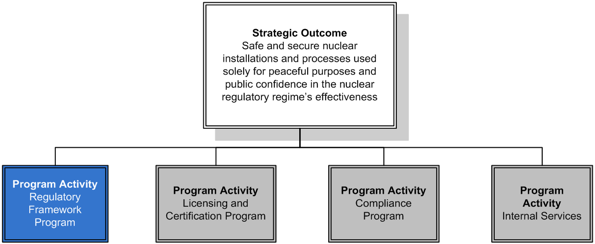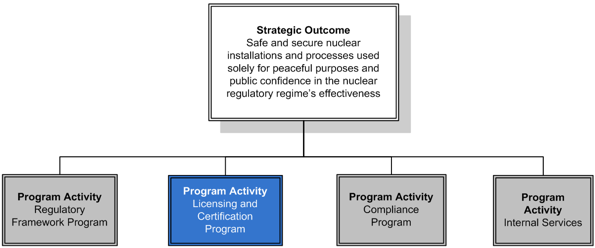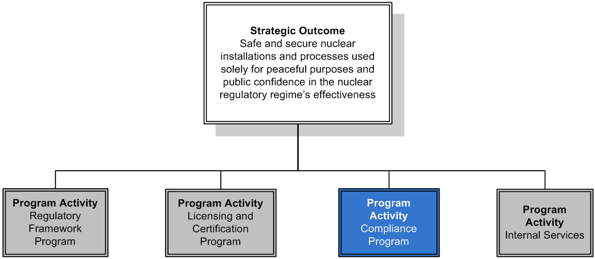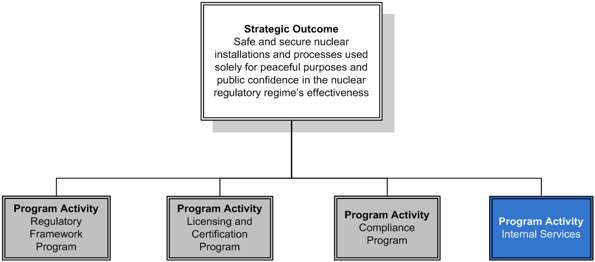Common menu bar links
Breadcrumb Trail
ARCHIVED - Canadian Nuclear Safety Commission
 This page has been archived.
This page has been archived.
Archived Content
Information identified as archived on the Web is for reference, research or recordkeeping purposes. It has not been altered or updated after the date of archiving. Web pages that are archived on the Web are not subject to the Government of Canada Web Standards. As per the Communications Policy of the Government of Canada, you can request alternate formats on the "Contact Us" page.
Section II - Analysis of Program Activities by Strategic Outcome
The Canadian Nuclear Safety Commission has a single strategic outcome: safe and secure nuclear installations and processes used solely for peaceful purposes and public confidence in the nuclear regulatory regime's effectiveness. To support this outcome, the CNSC has four program activities: regulatory framework; licensing and certification; compliance; and internal services.
The following section describes the CNSC's program activities and identifies the expected results, performance indicators and targets for each of them. This section also explains planning highlights and benefits for Canadians, and presents the financial and non-financial resources that will be dedicated to each activity.
2.1.1 Program Activity: Regulatory Framework

| Human Resources (FTEs) and Planned Spending ($ thousands) | |||||
|---|---|---|---|---|---|
| 2010-11 | 2011-12 | 2012-13 | |||
| FTEs | Planned Spending | FTEs | Planned Spending | FTEs | Planned Spending |
| 120 | 19,407 | 102 | 16,065 | 102 | 16,100 |
| Program Activity Expected Results | Performance Indicators | Targets |
|---|---|---|
| A clear and pragmatic regulatory framework | Satisfaction levels of stakeholders across key performance areas |
Increasing trend in survey results over a three-year period, stable thereafter |
| Number of legal challenges to the regulatory framework | Minimal/declining number of challenges and/or high success rate of defending challenges |
Program Activity Description
The Regulatory Framework program is in place to ensure that Canadians—and licensees, in particular—have a clear and pragmatic regulatory framework for the nuclear industry in Canada.
Funds are used to develop and make amendments to those regulations (such as the Nuclear Safety Control Act and regulations under the Act; regulatory documents, such as policies, standards and guides; the Safeguards Agreement and Additional Protocol between Canada and the International Atomic Energy Agency, and Canada's bilateral Nuclear Cooperation Agreements) that protect the health, safety, security, and environment for Canadians, while implementing Canada's international commitments on the non-proliferation of nuclear weapons.
The CNSC also administers the Nuclear Liability Act and, as a Responsible Authority under the Canadian Environmental Assessment Act, carries out environmental assessments for nuclear projects in accordance with this legislation.
The following table aligns the Regulatory Framework Planning Highlights with their corresponding organizational priorities, and presents the planned timeline for completion.
| Planning Highlights | Timeline for Completion |
|---|---|
| Core regulatory operations | |
| Strengthen management and governance of Regulatory Framework Program | Ongoing |
| Fulfill regulatory oversight to support Canada's obligations on the peaceful use of nuclear materials and technology | Ongoing |
Organizational Priority: Commitment to ongoing improvements |
|
Strengthen regulatory analysis and research to support:
|
March 31, 2011 |
Prepare for new builds
|
March 31, 2011 |
Organizational Priority: Clarity of requirements |
|
Drive regulatory framework priorities
|
March 31, 2011 |
| Review nuclear security, safety, and emergency management policies and procedures post-September 11, 2001. | March 31, 2011 |
| Update environmental and radiation protection under the Nuclear Safety and Control Act. | |
|
September 2010 |
|
March 31, 2011 |
| Consult with Aboriginal communities (First Nations, Métis, Inuit) on the CNSC approach to the licensing and regulatory oversight of nuclear projects, such as nuclear power plants, uranium mines and mills and nuclear waste management facilities, on their Aboriginal rights or title (the duty to consult can be triggered by a variety of CNSC regulatory matters). | 2010-11 |
| Continue to work with its Major Projects Management Office (MPMO) partners to coordinate regulatory activities related to major nuclear projects, including nuclear power plants, uranium mines and mills, and nuclear waste management facilities; share best practices; undertake and integrate policy review initiatives; and advance administrative, regulatory and legislative options to modernize and streamline the federal regulatory system for project reviews - from environmental assessment to licensing. | Ongoing |
Organizational Priority: Communications |
|
| Continue to implement proactive disclosure. | Ongoing |
| The CNSC will explore renewing and updating an existing memorandum of understanding with Health Canada to improve information sharing, analysis, and collaboration. | March 31, 2011 |
Benefits for Canadians
The CNSC maintains an evergreen assessment of the Nuclear Safety and Control Act(NSCA) to fulfill its mandate, and continuously works with other national and international organizations to ensure that nuclear energy and materials are regulated effectively. Through its work with these partners, the CNSC is able to share best practices and lessons learned, and maximize its efficiency.
This program activity also aims to ensure that the CNSC's non-licensee and non-governmental related stakeholders are informed on the activities, policies, programs and the role of the CNSC, and that they have an opportunity to ask questions and express their views. It provides objective scientific and technical information on the areas regulated by the CNSC, and engages stakeholders, by soliciting their input on regulatory issues to enhance the quality of the organization's work and decisions. Licensees and government stakeholders (both domestic and international) are also appropriately informed about, and/or consulted on the role, activities, policies, and programs of the CNSC.
2.1.2 Program Activity: Licensing and Certification

| Human Resources (FTEs) and Planned Spending ($ thousands) | |||||
|---|---|---|---|---|---|
| 2010-11 | 2011-12 | 2012-13 | |||
| FTEs | Planned Spending | FTEs | Planned Spending | FTEs | Planned Spending |
| 215 | 27,709 | 214 | 27,738 | 214 | 28,227 |
| Program Activity Expected Results | Performance Indicators | Targets |
|---|---|---|
Individuals and organizations that operate safely and conform to safeguards and non-proliferation requirements |
Number of licences and certificates issued as per service standards | Meet external performance service standards |
Program Activity Description
The Licensing and Certification program is in place to issue licences or certify persons or organizations to conduct nuclear-related activities in Canada.
With this program activity's funding, the CNSC obtains evidence of the applicant licensees' ability to operate safely and comply with nuclear safeguards and non-proliferation requirements.
The CNSC undertakes this work to obtain assurance that nuclear activities and facilities in Canada are conducted with adequate provision for protection of health, safety, security and the environment and the fulfillment of commitments to the peaceful use of nuclear energy.
The following table aligns the Licensing and Certification Planning Highlights with their corresponding organizational priorities, and presents the planned timeline for completion.
| Planning Highlights | Timeline for Completion |
|---|---|
| Core regulatory operations | |
| Undertake licensing and certification work. | Ongoing |
| Conduct licensing hearings. | |
|
June 30, 2010 |
|
December 31, 2010 |
| Undertake regulatory oversight of Pickering B life extension activities. | Ongoing |
| Undertake regulatory oversight of return-to-service of Bruce A Units 3 and 4 following refurbishment. | Ongoing |
| Undertake regulatory oversight of preparations for refurbishment of Bruce B Units 3 and 4. | Ongoing |
| Develop a relicensing strategy for the refurbishment of all Darlington Units. | Ongoing |
| Undertake regulatory oversight of commissioning activities for design modification/upgrades and return-to-service following refurbishment of Point Lepreau. | Ongoing |
| Execute project plans for new uranium mine applications. | March 31, 2011 |
| Execute project plans for the Darlington Joint Review Panel | |
|
March 31, 2011 |
| Start execution of project plan for Ontario Power Generation's Deep Geologic Repository. | March 31, 2011 |
| Port Hope Area Initiative | |
| Port Hope Project | |
|
2010 |
|
March 31, 2011 |
| Port Granby Project | |
|
March 31, 2011 |
| Organizational Priority: Commitment to ongoing improvements "Always room for improvements" |
|
| Prepare for new builds | |
|
March 31, 2011 |
| Develop and implement policy on the applications of Periodic Safety Review (PSR) for the ongoing operations of Nuclear Power Plants. | March 31, 2011 |
Organizational Priority: Clarity of requirements |
|
| Clarify and streamline abridged hearing process. | March 31, 2011 |
| NRU re-licensing – continue to implement the protocol for licensing renewal | 2010-11 |
|
July 2010 |
|
October 2010 |
|
November 2010 |
|
January 2011 |
| CNSC will ensure regulatory framework for facilities for isotope production is up-to-date, and provide guidance and assistance to potential proponents submitting applications for isotope production. | March 31, 2011 |
| Licence reform | |
|
March 31, 2011 |
Benefits for Canadians
This program activity is central to meeting the CNSC's mandate, by ensuring that applicants for licenses and certificates fully meet the requirements of the NSCA and related legislation before they are permitted to engage in any activity with a nuclear component.
2.1.3 Program Activity: Compliance

| Human Resources (FTEs) and Planned Spending ($ thousands) | |||||
|---|---|---|---|---|---|
| 2010-11 | 2011-12 | 2012-13 | |||
| FTEs | Planned Spending | FTEs | Planned Spending | FTEs | Planned Spending |
| 273 | 38,868 | 254 | 36,707 | 254 | 37,481 |
Canada's Economic Action Plan (CEAP) |
|||||
| - | 1,000 | ||||
| Program Activity Expected Results | Performance Indicators | Targets |
|---|---|---|
A high level of compliance by licensees with the regulatory framework |
Frequency and severity rate of accidents | Targets set on an annual work planning basis |
| Degree/level of reconciliation between Canada and other countries to nuclear inventories subject to bilateral Nuclear Cooperation Agreements (NCAs) | 100% | |
| Adherence with Sealed Source Tracking requirements | All on time; 100% match with registry. | |
| Nuclear material "ledger" reconciliations between the CNSC and licensees | Identical inventory records on reconciliation of nuclear material. |
Program Activity Description
The Compliance program is in place to ensure that CNSC licensees exhibit a high level of compliance with the CNSC's regulatory framework. This program enables the CNSC to provide regulatory assurance to Canadians of the continuing compliance and safety performance of licensees.
This program activity's funding is used for the promotion of compliance, safety culture and common safety values, compliance audits, inspections, and enforcement actions.
The following table aligns the Compliance Planning Highlights with their corresponding organizational priorities, and presents the planned timeline for completion.
| Planning Highlights | Timeline for Completion |
|---|---|
| Core regulatory operations | |
| Deliver on baseline compliance. | |
|
Ongoing |
Organizational Priority: Commitment to ongoing improvements |
|
| Strengthen the CNSC's inspector training process to ensure the CNSC is prepared to train the next generation of inspectors. | March 31, 2011 |
| Strengthen the CNSC's inspection procedures to ensure there is a consistent approach to inspections of all nuclear facilities and activities. | March 31, 2011 |
| Strengthen integration of operational experience feedback in our compliance activities. | Ongoing |
Organizational Priority: Capacity for action |
|
| Laboratory project – continuous improvement | |
|
March 31, 2011 |
| Update risk-informed compliance approach. | March 31, 2011 |
| Document standard approach to technical assessments. | March 31, 2011 |
Organizational Priority: Communications |
|
| Develop industry report for nuclear substance licensees. | March 31, 2011 |
| Develop industry reports for nuclear cycle and facilities. | March 31, 2011 |
Benefits for Canadians
The CNSC can assure Canadians that its licensees are operating in compliance with their licences, regulations, and underlying legislation, as well as with bilateral Nuclear Cooperation Agreements.
Our Daily Activities
The majority of the CNSC's work involves undertaking licensing and compliance activities in a risk-informed fashion, to ensure that licensees meet regulatory requirements set out in regulations and in their licences. This requires maintaining an adequate level of regulatory vigilance, and being prepared to react according to credible information received.
Much of the compliance work is in the form of inspections of varying types. A Type I inspection is a systematic and documented process to determine, through objective evidence, whether a licensee program, process or practice complies with regulatory requirements; these inspections are similar to an audit or program evaluation. Type II inspections are planned and documented activities to verify the results of licensee processes and not the processes themselves. They are typically routine (item-by-item) inspections and rounds, usually of specified equipment, facility material systems, or of discrete records, products or outputs from licensee processes. A desktop review is the CNSC staff analysis of compliance reports submitted by licensees, with the aim to evaluate if the licensee is complying with the requirements of the regulatory framework.
Typically, in a fiscal year, the CNSC will undertake approximately 100 Type I inspections, 1,800 Type II inspections and numerous desktop reviews.
2.1.4 Program Activity: Internal Services

| Human Resources (FTEs) and Planned Spending ($ thousands) | |||||
|---|---|---|---|---|---|
| 2010-11 | 2011-12 | 2012-13 | |||
| FTEs | Planned Spending | FTEs | Planned Spending | FTEs | Planned Spending |
| 242 | 44,438* | 225 | 40,928* | 225 | 41,917* |
* Includes both Internal Services operating funds and CNSC's capital funding applicable to all Program Activities.
| Program Activity Expected Results |
|---|
| Activities and resources administered to support the needs of programs and other corporate obligations. |
Program Activity Description
Internal services are activities and resources to enable and support program delivery and meet other corporate obligations of the Commission, as an agency of government.
These activities are: Management and Oversight (including Audits and Evaluations); Communications; Legal Services; Human Resources Management; Financial Management; Information Management; Information Technology; Real Property and Materiel Acquisition; Travel and Other Administrative Services.
Internal Services include only those activities and resources that apply across the organization and not to those provided specifically to a given program.
The following table aligns the Internal Services Planning Highlights with their corresponding organizational priorities, and presents the planned timeline for completion.
| Planning Highlights | Timeline for Completion |
|---|---|
Organizational Priority: Capacity for action |
|
| Continue improvements to the Revenue Spending Authority Regime by introducing integrated reporting, more critical analyses and simplified costing methods. | Ongoing |
| Re-focus Human Resources activities (from recruitment) to retention and training in line with Employer of Choice efforts, specifically: | |
|
March 31, 2011 |
|
March 31, 2011 |
| Focus Information Management and Technology capacity to deliver on key compliance and tracking deliverables, e-commerce, corporate reporting, and web communications. | March 31, 2011 |
| Establish evaluation function | |
|
March 31, 2011 |
Organizational Priority: Commitment to ongoing improvements |
|
| Continue Service Level and Policy Improvements in support of Harmonized Plan. | March 31, 2011 |
| Develop and enable Management Accountability Framework (MAF) Action Plan in response to Round VII Assessment. | March 31, 2011 |
Benefits for Canadians
The above profile of Internal Services reflects a structure applied across government to support a common government-wide approach to planning, design, budgeting, reporting and communications of government internal services.
The Internal Services enable public programs, as well as other internal services, to operate more efficiently and effectively.
